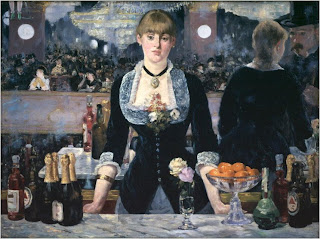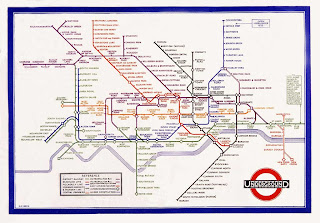- Modernism - e.g- ikea furniture, mini skirts, stilletto heels, new, different
- Modernity - Industrialisation - A period in time 1750 - 1960...from then on modernism era.
- Modern - The theory is its better than old
Cailebatte 'Paris on a rainy day' 1877
This painting is showing this to be the new Paris - a city of both new and ancient aspects. This painting doesn't have a focus point; this was a new era of painting, previously all artists would have a focal point within a piece, this shows Paris as a whole, containing many elements of the city - this becomes the subject of art, a personification of modernity - again linking to this term, the lifestyle shown within this painting shows clothes signify identity, displaying status and wealth. A modern way of life is displayed though the activity of walking the streets showing your wealth to be a new leisurely activity.
Haussmanisation
To re-design Paris, in 1850, it was modernised. Old Paris as renound for narrow street, and was quite run down. Crime was at a high level, and the need for a re-design for more people to be attracted to the city was at a need. So the 'New Paris' was in favour of large boulevards; making streets easier to police. But in order for this to be done, many building needed to be removed, and as a result, this pushed out the working class to the outer city. The centre of the city was now an upper class area, promoting the image of the once run down city.
Paintings now show alienation, people looking at change and modernity - ponde Europe.
William Holman Hunt, The hireling shepherd, 1851
This painting, really is a symbol of modernism itself. Containing a moral lesson, in this case, the man has been distracted by a beautiful woman. Whilst all of his attention is on her, the flock of sheep he is meant to be keeping is eating crops and causing mischief. Overall it's sending the message to keep focus on what your doing and not to get distracted. This is a new method of painting - rather than just being aesthetically pleasing, it now has a 'modern' purpose.
Urbanisation
People start to shift towards towns - Industrialisation, life now goes from rural to urban. Changed in transport, new roads are built, ships are available to public, the telephones invented, railways expanded - people are no longer seperate from everyone, and can shift great distances. There are also new forms of leisure, the cinema, galleries, shopping is now considered a leisureable activity. Before modernity there was no regulated time, but within the modern era, there is now a regulated time agreed, meaning work within factors now consist of shifts.
Enlightenment
This was a period in the late 18th century, in which scientific thinking makes leaps and bounds, no longer relying of religion - secularisation-a new way of life.
Phycology
An 'Experiment of attentiveness to sound location' was done within 1893. People were now becoming afraid modernity was affecting us. The city was now a condensed social space, in which the poor and rich were forced to see eachother, making people distance - dehumanising city space. There was an obvious class division.
Seuret 'Sunday afternoon on La Grande Jatte' shows a new method of painting, the use of dots to create an entire image, developing a new science. This image shows the mixing of classes, the lower class sitting on the bank whilst the upper class sale in their yachts, showcasing their wealth. This shows a condensed social space, the poor and rich forced to see each, making people more distant and dehumanising city space.
'L'absinthe - Degas 1876. This really is an iconic painting, showing the negative impact of modernity, portraying life as terrible, alienated. Here a woman is seen to be 'drowning her sorrows' at the state of modern life and social relations.
Manet - Bar at the Flies Bergere 1881
Serving the wealthy, so part of it, but not allowed to access it completely, just works for the upperclass.
The Kaiser panorama was invented in 1883, a new distancing device, people apparently now prefer to see the world through a lens than realistically.
The cinema was also invented, which as it came about, the moving image terrified people but also became a fascination as a new way of the world. Of course, there were anti-modernists, who were fearful of what was happening.
Subjective experience: Experience of individual in modern world. Artists now gave a subjective response to the conditions. Modernism emerges out of the subjective responses of artists and designers to modernity.
Alfred Stieglitz - Flatiron Building - 1903.
This really evokes the message of modern towering above natural, and it itself it a product of modernity, it's form was dictated by purpose, and is yet another way of seeing the world, from high above.
New methods of work came about, Paul Citreon, metropolis, 1923, uses photomotage.
Modernism in design.
Define:
Truth to materials: should let new modern materials speak for themselves, e.g a metal chair, don't cover up to make it look wooden.
Form follows function - For a purpose, not aesthetics.
Anti-historicism - No need to look like an older style
'Ornament is crime' Adolf (1908)
Over flourishing - A sign of backwardness, should have no desire to over aestheticise.
Bahaus - No nonsense, purely functional, not beautiful - this comes form simplicity. Truth to materials, simple, geometric forms appropriate to the material being used. Bahaus designed the vetura font, and re-wrote how art was taught. The building in which this was done was shut down by the nazi's as they felt it was too progressive.
Bahaus, 'Le corbusier lc2'
New materials also came about:
Concrete
Steels
Plastics
Aluminium
REI Glas
Mass production was also quicker and cheaper.
Le corbusiers "Plan voisin' 1927
This was his ideal city design
Internationalism: a language of modern architecture design that could be understandable by anyone in all cultures and backgrounds - can be understood on an international basis.
Harry Beck, Underground Map, 1933
Herber Bayers - Sans Serif typeface, argued there's no need for caps, everything should be in lowercase.
Times new roman - Stanley Morison - 1932
Created at the same time as Ventura
Aiming to bring linear, classical and contempory
Frakhur Font
Nazi's used, roots to gothic empire
Modernity 1750-1960 social and cultural experience
Modern - Not a neutral term, suggests novelty and improvement
Importance of modernism
Vocabulary of style, art and design education, idea that form follows function.
Modernism - the range of ideas that sprang from modernity.












No comments:
Post a Comment